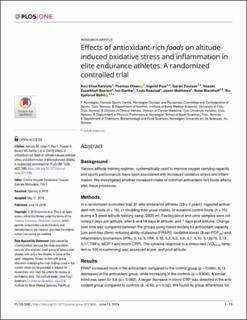Effects of antioxidant-rich foods on altitude-induced oxidative stress and inflammation in elite endurance athletes: A randomized controlled trial
Koivisto, Anu; Olsen, Thomas; Paur, Ingvild; Paulsen, Gøran; Bastani, Nasser Ezzatkhah; Garthe, Ina; Raastad, Truls; Matthews, Jason; Blomhoff, Rune; Bøhn, Siv Kjølsrud
Peer reviewed, Journal article
Published version

View/
Date
2019Metadata
Show full item recordCollections
- Artikler / Articles [2096]
- Publikasjoner fra Cristin [1084]
Abstract
Background: Various altitude training regimes, systematically used to improve oxygen carrying capacity and sports performance, have been associated with increased oxidative stress and inflammation. We investigated whether increased intake of common antioxidant-rich foods attenuates these processes.
Methods: In a randomized controlled trial, 31 elite endurance athletes (23 ± 5 years), ingested antioxidant-rich foods (n = 16), (> doubling their usual intake), or eucaloric control foods (n = 15) during a 3-week altitude training camp (2320 m). Fasting blood and urine samples were collected 7 days pre-altitude, after 5 and 18 days at altitude, and 7 days post-altitude. Change over time was compared between the groups using mixed models for antioxidant capacity [uric acid-free (ferric reducing ability of plasma (FRAP)], oxidative stress (8-epi-PGF2α) and inflammatory biomarkers (IFNγ, IL1α, IL1RA, IL1β, IL2, IL5, IL6, IL7, IL10, IL12p70, IL13, IL17, TNFα, MCP-1 and micro-CRP). The cytokine response to a stress-test (VO2max ramp test or 100 m swimming) was assessed at pre- and post-altitude.
Results: FRAP increased more in the antioxidant compared to the control group (p = 0.034). IL13 decreased in the antioxidant group, while increasing in the controls (p = 0.006). A similar trend was seen for IL6 (p = 0.062). A larger decrease in micro-CRP was detected in the antioxidant group compared to controls (β: -0.62, p = 0.02). We found no group differences for the remaining cytokines. 8-epi-PGF2α increased significantly in the whole population (p = 0.033), regardless group allocation. The stress response was significantly larger post-altitude compared with pre-altitude for IL1β, IL6, IL7, IL13, IL12p70 and TNFα, but we found no group differences.
Conclusions: Increased intake of antioxidant-rich foods elevated the antioxidant capacity and attenuated some of the altitude-induced systemic inflammatory biomarkers in elite athletes. The antioxidant intervention had no impact on the altitude-induced oxidative stress or changes in acute cytokine responses to exercise stress-tests.
Description
This is an open access article distributed under the terms of the Creative Commons Attribution License, which permits unrestricted use, distribution, and reproduction in any medium, provided the original author and source are credited.